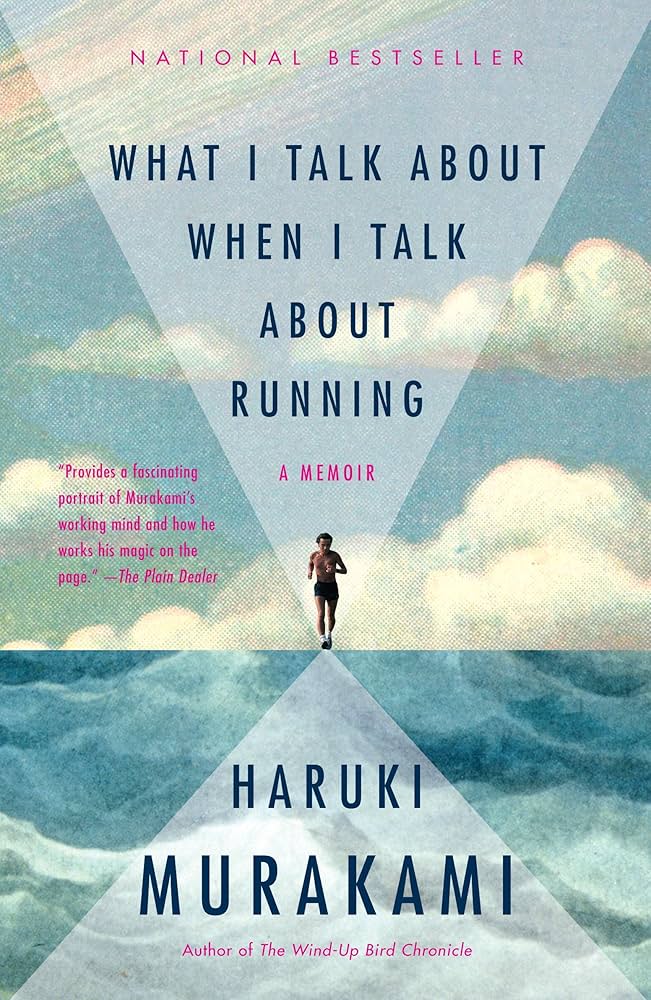What’s it about?
Part training log, part memoir, Murakami’s book tracks a year of running and thinking—from daily miles on the Charles River to marathons and triathlons—while exploring how running shapes his life as a novelist. It’s about craft, solitude, aging, pain, and the stubborn joy of doing a hard thing every day. No hype—just the quiet routine that keeps both his body and writing practice alive.
Book Review: What I Talk About When I Talk About Running

by Haruki Murakami
Published: 2007 (JP) / 2008 (EN)
Review published: September 8, 2025
What I Learned / My Take
1. “Pain is inevitable. Suffering is optional.” Murakami insists you can’t avoid pain in running—or in life—but you can decide how to carry it. That line has stayed with me as both mantra and warning.
2. Rhythm is survival: when fatigue hits, the only way forward is to keep the cadence. It’s less about speed than not breaking stride.
3. His “serious” mileage—thirty-six miles a week, six miles a day for six days—taught me that endurance is built on quiet, almost boring accumulation, not heroic bursts.
4. Goals matter more than competition: “I’m much more interested in whether I reach the goals I set for myself.” Running becomes a mirror of his writing ethic: self-directed, not applause-driven.
5. Solitude is his native mode—preferring books and music alone since childhood—but he acknowledges running also helped him grasp the importance of community and the fact that “we can’t survive on our own.”
6. Aging reframes ambition: from chasing faster times to chasing sustainability and balance. Pain, once feared, becomes part of what gives life texture. “As I’ve gotten older, I’ve gradually come to the realization that this kind of pain and hurt is a necessary part of life.”
7. Running as instinctive therapy: sometimes he pushes to the limit not to achieve a record, but to heal loneliness, to put pain in perspective. It’s less strategy than reflex.
8. The connection between miles and pages: the stamina of running bleeds into writing—discipline, patience, and the ability to keep going when the excitement fades.
Scenes and Images that Stuck with Me:
- The mantra on the road: repeating “pain is inevitable, suffering is optional” as a mental shield against exhaustion—transforming each mile into an internal negotiation.
- The thirty-six-mile week: seeing his calendar filled with steady six-mile entries, a portrait of consistency rather than drama.
- Lake Saroma ultramarathon: the punishing sun on the Hokkaido road, body unraveling, mind bargaining step by step.
- Cambridge loops: steady laps along the Charles River—same route, different seasons—an image of how repetition can become its own beauty.
- The New York City Marathon: swallowed by bridges and crowds, discovering the paradox of running: a solitary act done in a moving city of thousands.
- Jazz bar to runner: closing his late-night club, gaining weight, then reshaping himself through morning runs—proving identity can be rebuilt.
- Triathlon humility: awkward strokes in open water, fumbling on the bike, then finally home in the run—choosing discomfort as a path to growth.
- Loneliness healed by miles: running until pain reframes solitude, not as emptiness but as a kind of necessary silence.
Would I recommend it?
Yes—especially if you create things or want a sustainable routine. It’s not a training plan; it’s a philosophy of steadiness that makes space for work, health, and a quiet, durable kind of happiness.